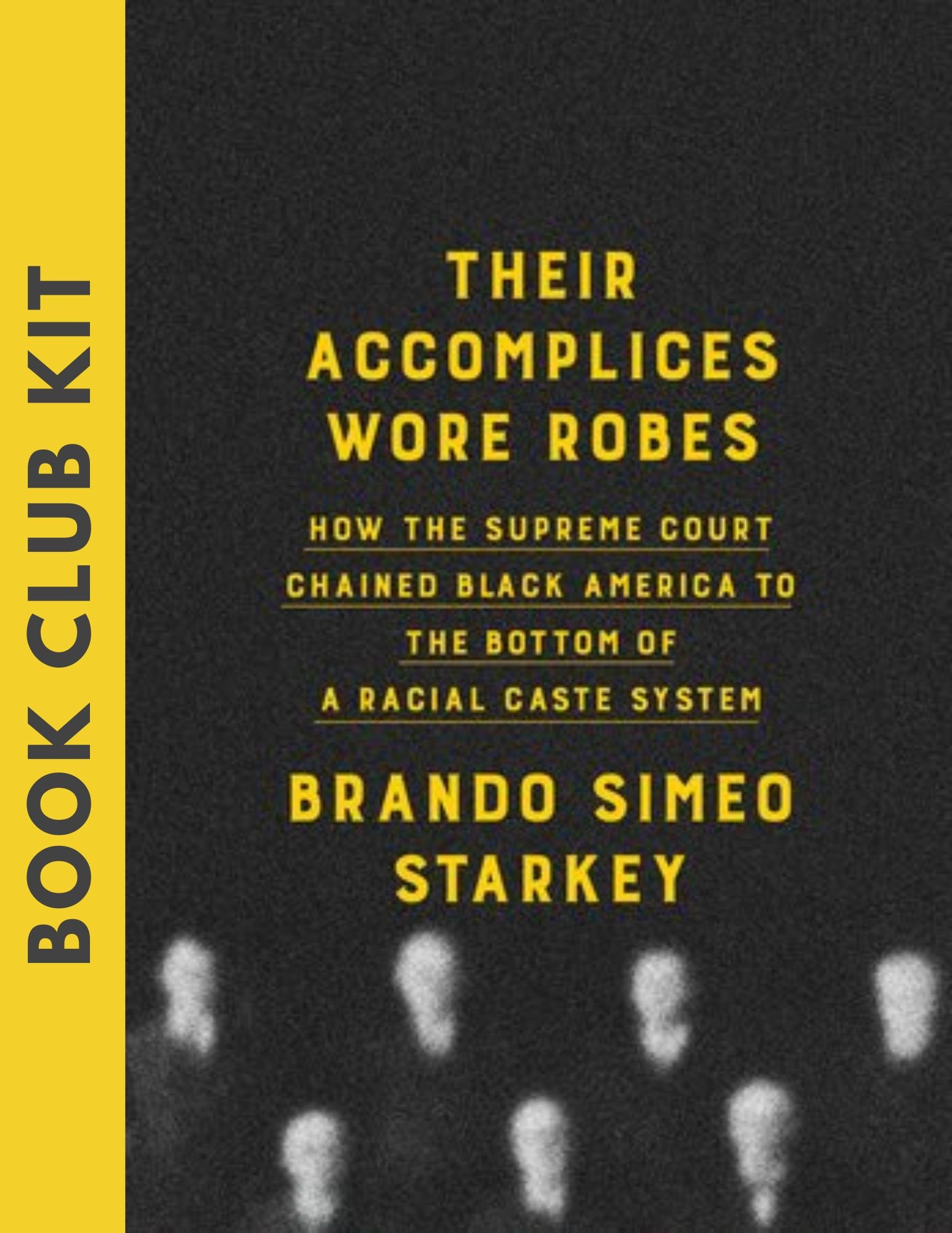Book Club Guide: Their Accomplices Wore Robes: How the Supreme Court Chained Black America to the Bottom of a Racial Caste System by Brando Simeo Starkey
Check out our Book Club Discussion Guide for Brando Simeo Starkey’s THEIR ACCOMPLICES WORE ROBES: How the Supreme Court Chained Black America to the Bottom of a Racial Caste System
At a time when our histories are being challenged, censored, and banned, we thought this pivotal piece of history demanded a spotlight.
The book documents the history of the role of the Supreme Court as an ally in implementing and preserving a racial caste system in America, and brings to life dozens of cases to explain how America arrived at this point and how we might arrive somewhere better.
As current and former library book club leaders with years of collective experience, we know nonfiction can be a tough sell for book-themed programs sometimes! However, it can also spark the most thoughtful, rewarding conversations.
So we’re here to encourage you, support you, and equip you with tools, questions, and ideas to engage with the book. Let’s dig into this history together, and come out more informed, armed with knowledge of our history, and ready to engage with the present.
Book Club Discussion Guide
“Vividly narrated and astute, this is a damning reassessment of the judicial branch’s civil rights legacy.” —Publisher’s Weekly (starred review)
“Precisely outlines, within the historical context of the United States, how the Supreme Court has repeatedly and specifically denied or significantly delayed full rights of citizenship to Black people. . . . Starkey masterfully uses a unique blend of storytelling and legal documentation to share his declarations.”
—Library Journal (starred review)
“A searing indictment of judicially condoned—and even enshrined—racism in American law. . . . A powerfully argued study of a legal system that favors those who ‘persevere in undermining Black freedom.'”
—Kirkus Reviews (starred review)
Discussion Questions
“A ‘state denies equal protection whenever it fails to give it.’”
Why was the United States Supreme Court created and what is its role in American government?
Before reading this book, did you think that there was a caste system present in the United States? What was your understanding of the caste system?
Their Accomplices Wore Robes primarily focuses on analyzing the Supreme Court’s historic rulings relating to the “Reconstruction Amendments” (the Constitution’s Thirteenth, Fourteenth, and Fifteenth Amendments.) Take a moment to look at a list of recent landmark decisions handed down by the United States Supreme Court. Do you see any elements of the caste preservationist ideology Brando Simeo Starkey outlined in Their Accomplices Wore Robes in recent decisions?
Did you learn about Jim Crow in school? What were you taught? Has your understanding of Jim Crow shifted over the years?
What would it look like, in your opinion, for the United States to live up to the ideals set forth in the Constitution and its amendments?
Brando Simeo Starkey and other authors like Isabel Wilkerson make compelling arguments that there is a caste system present in the United States. What would it look like for individual communities or the country as a whole to break free of this systemic oppression?
General Questions for Discussing Nonfiction
Have you read much about this topic before? How familiar were you with the concepts before you dug in?
Was there a chapter or passage that stood out for you or gave you an “a-ha!” moment about the topic?
How does your own background influence how you interpreted the book?
Did anything in the book feel uncomfortable or difficult to read? How did you respond to that discomfort?
Did this book change your perspective? If so, how will it impact your life going forward?
What do you know about the author? Have you read or engaged with their other work (books, articles, blog etc..)?
If you could ask the author one question to dig deeper into the book, what would it be?
Were there any supplemental materials that would have helped you understand the book better? For example an accompanying or related podcast, documentary, or lecture?
What is your greatest takeaway from reading the book?
Is this a book you’ll still be thinking about in six months? Why?
Dig Deeper: Unique Event Ideas
Silent Book Club makes a great addition to your regular book club, by setting aside some time during the moth to intentionally dig into your selected pick. Accountability is motivating!
Don’t let size discourage you! If you don’t think your group will have the time to read a longer tome in a month (the typical time between book club meetings) consider picking a particular chapter from the book you’d like to focus on, or if the chapters are quite topically diverse, have each member take one chapter to read.
A New Day with KALW is a recently launched live event series that seeks to understand the forces and people contributing to our current political moment - how we got here, what’s at stake, and what’s possible. Brando Simeo Starkey already spoke with KALW’s Sunni M. Khalid about his new book, but you can always bring Brando to speak at your event!
Uncovering Hidden Histories: Consider building an event around the book’s central theme: the overlooked or intentionally buried stories that shape our nation’s legal and social systems. Host a panel featuring authors, scholars, or activists to spotlight pivotal but little-known figures or moments in history—think of it as a “History Detectives” roundtable.
Hidden Histories Storytelling Night: You could also follow the series up with a storytelling night that invites participants to share their own hidden histories—family stories, cultural memory, or moments of legal injustice that rarely make it into textbooks. This kind of event helps draw powerful connections between the book’s content and the lived experiences of your community.

